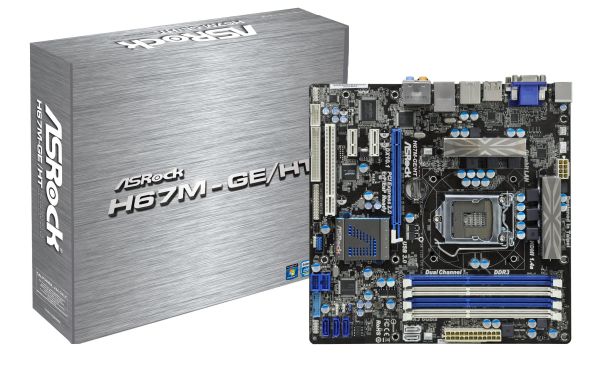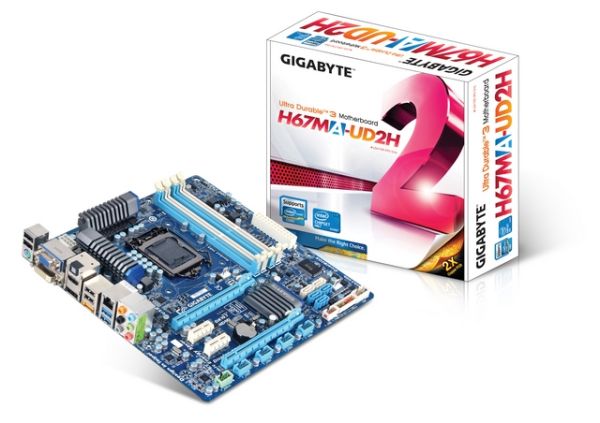H67 – A Triumvirate of Tantalizing Technology
by Ian Cutress on March 27, 2011 6:25 PM EST- Posted in
- Motherboards
- Sandy Bridge
- H67
Overview
With Intel’s recall at the beginning of the year, just after release, vendors are now starting to make versions of their fixed chipsets available to end users. As I mentioned at the very beginning of this review, what we are technically looking at are the B2 samples, as these were distributed to us before the recall. Every manufacturer here has confirmed that the B3 versions of these boards perform exactly the same as the B2, but will either be released with the same name but a B3 sticker on the box, or the name will be adapted with the B3 edition – so the Gigabyte H67MA-UD2H becomes the Gigabyte H67MA-UD2H-B3.
With H67, we lose the CPU overclocking of the P67 and all the dual GPU lanes, and instead get access to the integrated GPU on the processor. As a result, manufacturers do not have to provide the H67 with oodles of high-quality VRMs to hold high CPU overclocks amongst other things, which bring the costs down. As such, our boards here are $120 (ASRock), $140 (ECS) and $125 (Gigabyte).
ASRock H67M-GE/HT
The ASRock H67M-GE/HT is relatively easy to use and performs well in our benchmark suite. At $120, with the additions in the package in the board, makes this a relatively comfortable H67 product. It does not have the features of some of the more expensive boards, such as a Debug LED and Power/Reset buttons, but once the board is installed in a case, it is quite rare that you will need these again. The board has legacy floppy connectors and a PS/2 keyboard port, which may be a selling point for some buyers still running legacy equipment. The H67M-GE/HT also runs cooler than other Sandy Bridge boards I have tested. The ASRock board comes with a one year warranty, with an option to extend for another year.
ECS H67H2-M
The ECS H67H2-M has a few serious check points against it as a board to use. The RAM timings in the BIOS are not changeable; the BIOS can be hard to navigate and does not implement any of the newer UEFI principles coming through with Sandy Bridge; the USB performance is sub-par, and the DPC Latency is the highest of the H67 boards we have tested. There are some very positive points with it – eJiffy is a great piece of software, you have double gigabit Ethernet ports, Power/Reset buttons on the board and a Debug LED, the 2D performance is better than average, and your fan options are better than some other vendors. I would prefer to see a cleaner BIOS, more fan headers and better USB performance become as standard. The ECS board comes with a three year warranty.
Gigabyte H67MA-UD2H
The Gigabyte H67MA-UD2H does not have a lot of physical features, unless you have need of lots of external USB ports. While it offers some BCLK overclocking, there are not enough fan headers on the board to support basic all-in-one water cooling, or more than one case fan. The SATA ports are oddly further into the board which is not ideal. The BIOS is however rock solid and simple to use, which is no small feat. The PCIe slots are not ideally laid out (I would prefer x1, x16, x1, x4), and in their current configuration would restrict RAM coolers when using a dual slot, long GPU. There are no Power/Reset buttons, no Debug LED, but the software included works and does its job. For $125, the ASRock beats it in bang for buck, but people will not be disappointed if they picked up the H67MA-UD2H (or rather, its B3 equivalent, the H67MA-UD2H-B3). The Gigabyte board comes with a three year warranty.
Conclusion
There are a lot of options in the world of H67 but there are also a lot of pitfalls. For a board to have all the bells and whistles (presumably, some imaginary board with all the best bits from every other board), you would easily be pushing into P67 price territory and then some more. There is not much between all the boards in terms of performance, so you may end up looking at what is included with the board or features for a final decision.
The biggest surprise for me however is the loss of a multiplier on single-threaded loads on H67. On all three boards, the BIOS/UEFI had 37x multiplier set for single thread loads, but in the OS, it would only ever go to 36x. We're told that this is part of the Intel chipset specifications for H67, but this ultimately means that the consumer is losing that multiplier. Only with the Gigabyte board (out of these three) can you overcome this with BCLK overclocking, but ultimately that overclocking can be quite variable chip-to-chip.



01_575px.png)









56 Comments
View All Comments
james.jwb - Sunday, March 27, 2011 - link
"However, I remember the time when I was a scrimping student. I wanted high gaming performance at the lowest cost – if Sandy Bridge was out then, and I was specifically after the Sandy Bridge platform over anything AMD, then a H67 with an i3-2100 and the biggest graphics card I could afford would be a viable option."When I was in this position, i'd go for the cheapest CPU and overclock it so it was faster than anything on the market. I'd be surprised if this wasn't the norm for people on a tight budget.
IanCutress - Sunday, March 27, 2011 - link
My argument mainly for my comment is that the CPU is becoming less of a factor for gaming, thus shifting the focus away from a CPU OC to a large GPU. It used to be the case that the CPU made a large difference as well, but it my mind it's not that much of an issue with a strong default CPU speed and cores available. Nevertheless, the AMD + cheap tri/quad core is on the other side of the coin.Ian
slickr - Monday, March 28, 2011 - link
Intel mobos are crap. Only for overclocking and only for graphics, where is the middle?And they are too expensive, hopefully AMD wipes the floor with them with their new Buldozer platform.
Jeffs0418 - Sunday, May 22, 2016 - link
Here we are 5 years later and...Y'know I was ready to move on from my Athlon 64 x2 5000+/AM2 platform(which I liked but was marginal for modern gaming). I was stoked for a nice capable FX4100/Bulldozer platform. But after reading disappointing reviews I ended up with a Core i3 2120/Sandy Bridge and a H61 mobo. Currently running a Core i5 2500(non-k) massaged a bit to 3.9GHz on all cores with aftermarket cooling on P67 mobo. Never have used Intel integrated graphics so I couldn't care less about that. But I am glad I didn't go with Bulldozer and am comfortable enough with my current setup even now that I'm in no hurry to upgrade.omelet - Sunday, March 27, 2011 - link
Wouldn't someone wanting SB gaming on a budget be more likely to want an H61? You can get such a board from ASRock for like 60 bucks. That's $60 more you'd be able to spend on the GPU, and you'd still have every feature you need. The only real performance difference is that there's no SATA 6Gbps, but budget gamers don't have drives that need that anyway.yzkbug - Sunday, March 27, 2011 - link
Totally agree. I’m looking for a good, reliable, budget-priced motherboard for my new HTPC. Would love to see a comparison review of H61 motherboards, especially the power comparison numbers.Taft12 - Sunday, March 27, 2011 - link
I'd need to know at what point the 6 PCIE lanes on H61 begins to get in the way of the GPUs performance. Someone will surely do the testing to show us in the near future. Noticeable on, say, a 6850? Or do we need a much higher-end GPU for a bottlenect?DanNeely - Sunday, March 27, 2011 - link
The GPU would still be running on the 16 lanes from the CPU. You just have 2 less lanes for 2ndary slots and onboard devices. I don't think it's likely to be an issue except in that you're much less likely to get a second x4 slot (1/11 vs 6/16 on newegg), and the 1 H61 board that does it has legacy PCI slots for the other 2 spaces, while 5/6 H67 boards have at least 1 1x slot as well.omelet - Sunday, March 27, 2011 - link
This is very confusing. All the boards claim to have x16 slots, but they can't possibly run at x16 if none of the boards on the table even have 16 lanes. A P67 running two cards would have to run each at 4x, or even lower if there are any x1 slots on the board (as there are on most boards).It might be explained as being an x16 slot running at a lower speed, except for the fact that P67 and P55 both specify that they can run two cards at x8/x8, which can only mean that they run the x16 slots at 8 lanes each when you have two cards plugged in. That should also be impossible according to the table.
Other sources I've found on the internet seem to imply that the x16 slot on the H61 runs at full x16 speed. I think perhaps we just need some clarification on what the values on the table here mean.
ajp_anton - Sunday, March 27, 2011 - link
There are two sources for PCIe lanes. The CPUs all have x16 (only for graphics), the rest (what is shown in the table) come from the motherboard chip (H67 etc).